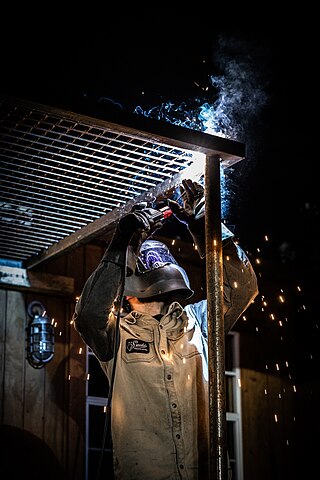
Welding is a fabrication process that joins materials, usually metals or thermoplastics, by using high heat to melt the parts together and allowing them to cool, causing fusion. Welding is distinct from lower temperature techniques such as brazing and soldering, which do not melt the base metal.

Spot welding is a type of electric resistance welding used to weld various sheet metal products, through a process in which contacting metal surface points are joined by the heat obtained from resistance to electric current.
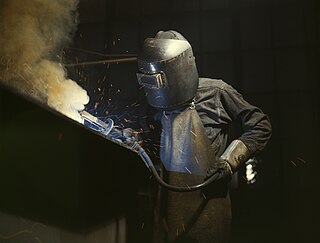
In a broad sense, a welder is anyone, amateur or professional, who uses welding equipment, perhaps especially one who uses such equipment fairly often. In a narrower sense, a welder is a tradesperson who specializes in fusing materials together. The term welder refers to the operator, the machine is referred to as the welding power supply. The materials to be joined can be metals or varieties of plastic or polymer. Welders typically have to have good dexterity and attention to detail, as well as technical knowledge about the materials being joined and best practices in the field.

Shielded metal arc welding (SMAW), also known as manual metal arc welding, flux shielded arc welding or informally as stick welding, is a manual arc welding process that uses a consumable electrode covered with a flux to lay the weld.

Arc welding is a welding process that is used to join metal to metal by using electricity to create enough heat to melt metal, and the melted metals, when cool, result in a binding of the metals. It is a type of welding that uses a welding power supply to create an electric arc between a metal stick ("electrode") and the base material to melt the metals at the point of contact. Arc welding power supplies can deliver either direct (DC) or alternating (AC) current to the work, while consumable or non-consumable electrodes are used.

Lincoln Electric Holdings, Inc. is an American multinational and global manufacturer of welding products, arc welding equipment, welding accessories, plasma and oxy-fuel cutting equipment and robotic welding systems headquartered in Euclid, Ohio. It has a worldwide network of distributors and sales offices covering more than 160 countries and 42 manufacturing locations in North America, Europe, Middle East, Asia and Latin America. It also operates manufacturing alliances and joint ventures in 19 countries. It is a member of the Fortune 1000.
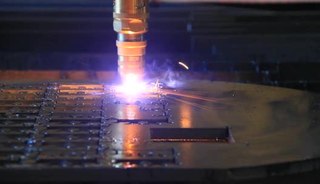
Plasma cutting is a process that cuts through electrically conductive materials by means of an accelerated jet of hot plasma. Typical materials cut with a plasma torch include steel, stainless steel, aluminum, brass and copper, although other conductive metals may be cut as well. Plasma cutting is often used in fabrication shops, automotive repair and restoration, industrial construction, and salvage and scrapping operations. Due to the high speed and precision cuts combined with low cost, plasma cutting sees widespread use from large-scale industrial computer numerical control (CNC) applications down to small hobbyist shops.

Gas tungsten arc welding (GTAW), also known as tungsten inert gas (TIG) welding, is an arc welding process that uses a non-consumable tungsten electrode to produce the weld. The weld area and electrode are protected from oxidation or other atmospheric contamination by an inert shielding gas. A filler metal is normally used, though some welds, known as autogenous welds, or fusion welds do not require it. When helium is used, this is known as heliarc welding. A constant-current welding power supply produces electrical energy, which is conducted across the arc through a column of highly ionized gas and metal vapors known as a plasma. TIG welding is most commonly used to weld thin sections of stainless steel and non-ferrous metals such as aluminum, magnesium, and copper alloys. The process grants the operator greater control over the weld than competing processes such as shielded metal arc welding and gas metal arc welding, allowing stronger, higher-quality welds. However, TIG welding is comparatively more complex and difficult to master, and furthermore, it is significantly slower than most other welding techniques. A related process, plasma arc welding, uses a slightly different welding torch to create a more focused welding arc and as a result is often automated.

A welding power supply is a device that provides or modulates an electric current to perform arc welding. There are multiple arc welding processes ranging from Shielded Metal Arc Welding (SMAW) to inert shielding gas like Gas metal arc welding (GMAW) or Gas tungsten arc welding (GTAW). Welding power supplies primarily serve as devices that allow a welder to exercise control over whether current is alternating current (AC) or direct current (DC), as well as the amount of current and voltage.

Robot welding is the use of mechanized programmable tools (robots), which completely automate a welding process by both performing the weld and handling the part. Processes such as gas metal arc welding, while often automated, are not necessarily equivalent to robot welding, since a human operator sometimes prepares the materials to be welded. Robot welding is commonly used for resistance spot welding and arc welding in high production applications, such as the automotive industry.
A welding helmet is a type of personal protective equipment used in performing certain types of welding to protect the eyes, face, and neck from flash burn, sparks, infrared and ultraviolet light, and intense heat. The modern welding helmet used today was first introduced in 1937 by Willson Products.
Kemppi Oy is a Finnish family owned welding company founded in 1949 by Martti Kemppi. It designs, and manufactures manual arc welding equipment, welding safety equipment and software, and automated welding machines. It also provides expert services in this field. In 2019, Kemppi had subsidiaries in 16 countries in addition to Finland. It employed over 800 people, half of them in Lahti city where the company also has its headquarters. In 2013 Kemppi's electronics factory was the largest in Finland. Kemppi's main business areas are Europe and Asia.

Hyperbaric welding is the process of welding at elevated pressures, normally underwater. Hyperbaric welding can either take place wet in the water itself or dry inside a specially constructed positive pressure enclosure and hence a dry environment. It is predominantly referred to as "hyperbaric welding" when used in a dry environment, and "underwater welding" when in a wet environment. The applications of hyperbaric welding are diverse—it is often used to repair ships, offshore oil platforms, and pipelines. Steel is the most common material welded.

Oxy-fuel welding and oxy-fuel cutting are processes that use fuel gases and oxygen to weld or cut metals. French engineers Edmond Fouché and Charles Picard became the first to develop oxygen-acetylene welding in 1903. Pure oxygen, instead of air, is used to increase the flame temperature to allow localised melting of the workpiece material in a room environment. A common propane/air flame burns at about 2,250 K, a propane/oxygen flame burns at about 2,526 K, an oxyhydrogen flame burns at 3,073 K and an acetylene/oxygen flame burns at about 3,773 K.
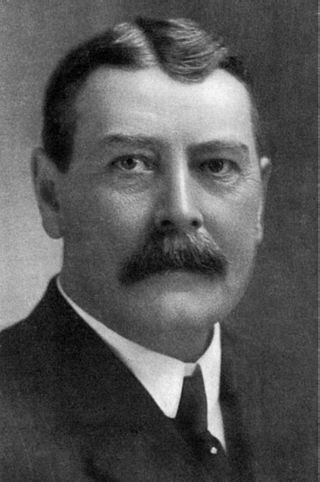
Joy Global Inc. was a company that manufactured and serviced heavy equipment used in the extraction and haulage of coal and minerals in both underground and surface mining. The company had manufacturing facilities in Alabama, Pennsylvania, Texas, Wisconsin, Australia, Canada, China, France, South Africa, Poland and the United Kingdom. In 2017, Joy Global was acquired by Komatsu Limited and was renamed Komatsu Mining Corp.

Welding goggles provide a degree of eye protection while some forms of welding and cutting are being done. They are intended to protect the eyes not only from the heat and optical radiation produced by the welding, such as the intense ultraviolet light produced by an electric arc, but also from sparks or debris. A full facemask may be required for arc welding.
Thermacut, Inc is an international corporation which designs, manufactures, and sells replacement torches, guns, consumables, and accessories for the metal cutting and welding industries. The company’s headquarters are located in Uherske Hradiste, Czech Republic. The company operates sales warehouses in the United States, Germany, and the Czech Republic along with sales offices located in Slovakia, Poland, Hungary, Croatia, Romania, Mexico Great Britain, Russia, China, France, and Brazil.
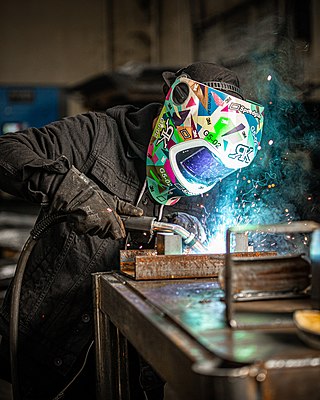
Gas metal arc welding (GMAW), sometimes referred to by its subtypes metal inert gas (MIG) and metal active gas (MAG) is a welding process in which an electric arc forms between a consumable MIG wire electrode and the workpiece metal(s), which heats the workpiece metal(s), causing them to fuse. Along with the wire electrode, a shielding gas feeds through the welding gun, which shields the process from atmospheric contamination.
voestalpine Böhler Welding is a manufacturer of welding consumables, welding equipment and accessories with headquarters in Düsseldorf. The company owns over 50 subsidiaries in more than 25 countries, 2,300 employees, customers in approximately 150 countries and more than 1,000 distribution partners.

Underwater cutting and welding are metalworking techniques used by underwater divers in underwater construction, marine salvage and clearance diving applications. Most underwater welding is direct current wet stick welding, and most underwater metal cutting is immersed oxygen-arc and shielded metal-arc cutting, though other technologies are available and sometimes used. These processes are mostly applied to steel structures as that is the most common arc-weldable material used in the underwater environment.

















